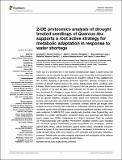Por favor, use este identificador para citar o enlazar a este item:
http://hdl.handle.net/10261/152860COMPARTIR / EXPORTAR:
 SHARE SHARE
 CORE
BASE CORE
BASE
|
|
| Visualizar otros formatos: MARC | Dublin Core | RDF | ORE | MODS | METS | DIDL | DATACITE | |

| Título: | 2-DE proteomics analysis of drought treated seedlings of Quercus ilex supports a root active strategy for metabolic adaptation in response to water shortage |
Autor: | Simova-Stoilova, Lyudmila P.; Romero-Rodríguez, Maria C.; Sánchez-Lucas, Rosa; Navarro, Rafael CSIC ORCID; Medina-Aunon, J. Alberto; Jorrín-Novo, Jesús V. | Fecha de publicación: | 14-ago-2015 | Editor: | Frontiers Media | Citación: | Frontiers in Plant Science 6: 627 (2015) | Resumen: | Holm oak is a dominant tree in the western Mediterranean region. Despite being well adapted to dry hot climate, drought is the main cause of mortality post-transplanting in reforestation programs. An active response to drought is critical for tree establishment and survival. Applying a gel-based proteomic approach, dynamic changes in root proteins of drought treated Quercus ilex subsp. Ballota [Desf.] Samp. seedlings were followed. Water stress was applied on 20 day-old holm oak plantlets by water limitation for a period of 10 and 20 days, each followed by 10 days of recovery. Stress was monitored by changes in water status, plant growth, and electrolyte leakage. Contrary to leaves, holm oak roots responded readily to water shortage at physiological level by growth inhibition, changes in water status and membrane stability. Root proteins were extracted using trichloroacetate/acetone/phenol protocol and separated by two-dimensional electrophoresis. Coomassie colloidal stained gel images were analyzed and spot intensity data subjected to multivariate statistical analysis. Selected consistent spots in three biological replicas, presenting significant changes under stress, were subjected to MALDI-TOF mass spectrometry (peptide mass fingerprinting and MS/MS). For protein identification, combined search was performed with MASCOT search engine over NCBInr Viridiplantae and Uniprot databases. Data are available via ProteomeXchange with identifier PXD002484. Identified proteins were classified into functional groups: metabolism, protein biosynthesis and proteolysis, defense against biotic stress, cellular protection against abiotic stress, intracellular transport. Several enzymes of the carbohydrate metabolism decreased in abundance in roots under drought stress while some related to ATP synthesis and secondary metabolism increased. Results point at active metabolic adjustment and mobilization of the defense system in roots to actively counteract drought stress. | Versión del editor: | http://dx.doi.org/10.3389/fpls.2015.00627 | URI: | http://hdl.handle.net/10261/152860 | DOI: | 10.3389/fpls.2015.00627 | ISSN: | 1664-462X |
| Aparece en las colecciones: | (CNB) Artículos |
Ficheros en este ítem:
| Fichero | Descripción | Tamaño | Formato | |
|---|---|---|---|---|
| 2-DE proteomics analysis of drought treated seedlings.pdf | 1,01 MB | Adobe PDF |  Visualizar/Abrir |
CORE Recommender
PubMed Central
Citations
21
checked on 10-abr-2024
SCOPUSTM
Citations
44
checked on 19-abr-2024
WEB OF SCIENCETM
Citations
41
checked on 29-feb-2024
Page view(s)
298
checked on 23-abr-2024
Download(s)
212
checked on 23-abr-2024

